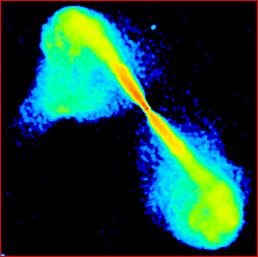 Image:
Image:3C 296 | B1414+110 |
| S178 | Alpha | FR | Class | ID | Spectrum | Best z | mag. | LAS | lg P178 | D |
|---|---|---|---|---|---|---|---|---|---|---|
| 14.2 | 0.67 | I | BTJ | Gal | 0.0237 | R = 11.43 | 437.00 | 24.08 | 192.6 |

| Size: | 382.5 × 384.0 arcsec² |
|---|---|
| LUT: | Logarithmic |
| Beam: | 4.9 arcsec |
| Frequency: | 1477 MHz |
| Method: | CLEAN/VTESS’ėˇ>4.9
|
| Telescope: | VLA B+C |
| Credits: | Leahy & Perley (1991) |
A radio-optical overlay and another version of this image are given in Alan Bridle's gallery.
Unlike most FR Is, 3C 296 is in a relatively low-density environment. Although NGC 5532 is surrounded by much smaller galaxies (which may however be in the background), and it has a comperably-sized neighbour, NGC 5531, 140 kpc to the north-west, there is not even a poor cluster, and the surrounding hot gas is too faint to show up in X-rays. Here is another source of confusion: 3C 296 is an X-ray source and this emission has often been discussed as if due to hot gas, but the ROSAT high-resolution image shows that it comes from within 2 kpc of the nucleus (Hardcastle & Worrall 1999) and it is very likely due to the AGN.
Nevertheless there is some gas around 3C 296, visible via its Faraday rotation of the radio polarization at long wavelengths (Garrington et al. 1996). From this we can tell that the the southern lobe is the more distant one, behind the gas. As the brighter jet is in the north, 3C 296 is an example of the Laing-Garrington effect.
The HST image of NGC 5532 (Martel et al. 1999) reveals a nearly edge-on dust disk roughly perpendicular to the radio jets. The disk is tilted enough to show that its south-western edge is closer to us, so if the jets are coming out along the disk axis, as jets usually do, this again confirms that the north-eastern jet is the closer.
High-resolution images of the inner jets are given by Hardcastle et al. (1997a), which clearly show the larger brightness asymmetry in the inner jets, as expected if the jets are slowing from initially relativistic speeds.
The bright point to the west of the north lobe is a background source;
another background source is partially visible in the bottom left corner of
the image. Other "lumpy" structure of the faint regions of our image is just
due to noise, as we don't have quite
enough sensitivity to see all the structure at this resolution. The C20 image
on the Other Images page shows that we are not missing much.
| Prev. | Data Page | Other images | Next | Search | Alphanumeric List | Icon List | Atlas Index |
|---|